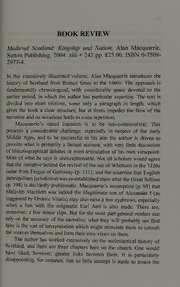
Review of Macquarrie; Medieval Scotland, kingship and nation PDF
Preview Review of Macquarrie; Medieval Scotland, kingship and nation
BOOK REVIEW Medieval Scotland: Kingship and Nation Alan Macquarrie. , Sutton Publishing, 2004. xiii + 242 pp. £25.00. ISBN 0-7509- 2977-4. In this extensively illustrated volume, Alan Macquarrie introduces the history of Scotland from Roman times to the 1460s. The approach is fundamentally chronological, with considerable space devoted to the earlier period, in which the author has particular expertise. The text is divided into short sections, some only a paragraph in length, which gives the book a clear structure, but at times impedes the flow of the narrative and on occasions leads to some repetition. Macquarrie’s stated intention is to be non-controversial. This presents a considerable challenge, especially in respect of the early Middle Ages, and to be successful in his aim the author is driven to provide what is primarily a factual account, with very little discussion of historiographical debates or even articulation of his own viewpoint. Most of what he says is unexceptionable. Not all scholars would agree that the initiative behind the revival ofthe see of Whithorn in the 1120s came from Fergus of Galloway (p. Ill), and the assertion that English metropolitanjurisdiction was re-established there after the Great Schism (p. 198) is decidedly problematic. Macquarrie’s assumption (p. 95) that Malcolm MacHeth was indeed the illegitimate son of Alexander I (as suggested by Orderic Vitalis) may also raise a few eyebrows, especially when a link with the enigmatic Earl Aed is also made. There are, moreover, a few minor slips. But for the most part general readers can rely on the accuracy of the narrative; what they will probably not find here is the sort of interpretation which might stimulate them to consult the sources themselves and form their own views on them. The author has worked extensively on the ecclesiastical history of Scotland, and there are three chapters here on the church. One would have liked, however, greater links between them. It is particularly disappointing, for instance, that so little attempt is made to assess the 196 extent to which twelfth-century developments transformed the structure and ethos ofthe Scottish church, or to discuss the degree of survival of ancient institutions and practices into the later Middle Ages. Ifearldoms and thanages are arguably Pictish in origin (p. 16), can a similar case not be made for the diocesan system north of the Forth? How readily could hermitages and houses ofceli de be adapted to the demands ofthe new monasticism and the development ofcathedral chapters? What was the relationship between the old mother-churches and the new parishes, and did it vary between different parts ofthe country? These are matters which Macquarrie, with his deep knowledge of the sources for the earlier period, is well placed to address, yet he offers little more than a brief description of the reforms. The picture he paints of the late medieval church is valuable, with welcome stress on the positive contribution made by several leading bishops, but it may be difficult for some readers to connect this with the earlier chapters, which explore rather different themes. The categorisation of prominent individuals in fifteenth-century Scotland as “papalists” and “conciliarists” is probably too stark, and the issue is hard to place into context without a deeper analysis of the domestic politics which undoubtedly influenced such choices of allegiance. The chronological scope of the book precludes much discussion of factors which may have helped bring about the Reformation, but something on (for example) the increasingly successful diversion of monastic revenues to magnate families would have provided a different slant on religious houses from that presented in the chapter on the twelfth century. In the introduction Macquarrie sets out as his theme the highly significant issue of how Scotland became a lasting, unified state when other Celtic regions such as Ireland, Wales and Brittany did not. He identifies three areas which are germane to this enquiry: kingship; national identity; and local identities and social cohesion. In fact, however, there is little detailed discussion of these issues. Macquarrie sagely notes that national identity remains an elusive concept, but declines to explore it in depth, while the shifting relationship between adherence to the crown and more local loyalties is barely considered at 197 all. There is plenty about kings, with brief accounts oftheir reigns, but much less about how the theory and practice of kingship contributed to the successful struggle for independence. It is, of course, possible that the very diversity of Scotland in linguistic and cultural terms was a strength rather than a weakness in this regard, and almost certain that prolonged warfare against a clearly definable enemy provided the circumstances in which a sense of identity could flourish; but the growing antipathy between Lowlands and Highlands in the later Middle Ages, and the intermittent exercise of royal authority after 1286, must raise questions about what, ifanything, held the polity together. It is the lack ofengagement with such fundamental issues which is the principal weakness ofthis book. While readers will receive a broad overview of more than a millennium of Scottish history, they will largely miss out on the often passionate debates which the sources and their interpretation have engendered among historians, and to which Alan Macquarrie himselfhas contributed so much. A. D. M. Barrell University ofYork
